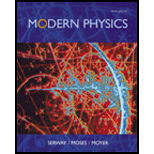
Concept explainers
(a)
The threshold for production of strange particles in the reaction
(a)
Answer to Problem 14P
The threshold for production of strange particles in the reaction
Explanation of Solution
Consider the reaction,
Write the expression for the threshold for production of strange particles in the reaction.
Here,
Conclusion:
Substitute
Therefore, the threshold for production of strange particles in the reaction
(b)
The threshold for production of strange particles in the reaction
(b)
Answer to Problem 14P
The threshold for production of strange particles in the reaction
Explanation of Solution
Consider the reaction,
Write the expression for the threshold for production of strange particles in the reaction
Conclusion:
Substitute
Therefore, the threshold for production of strange particles in the reaction
Want to see more full solutions like this?
Chapter 15 Solutions
Modern Physics
- A pion at rest (m = 273me) decays to a muon (m = 207me) and an antineutrino (mp 0). The reaction is written + v. Find (a) the kinetic energy of the muon and (b) the energy of the antineutrino in electron volts.arrow_forwardThe primary decay mode for the negative pion is +v . (a) What is the energy release in MeV in this decay? (b) Using conservation of momentum, how much energy does each of the decay products receive, given the is at rest when it decays? You may assume the muon antineutrino is massless and has momentum p = E/c , just like a photon.arrow_forwarda) A K° meson (mass 497.61 MeV/c2) decays to a t, T pair with a mean lifetime of 0.89 x 10-10 s. Suppose the K° has a kinetic energy of 276 MeV when it decays, and that the two A mesons emerge at equal angles to the original K° direction. Calculate the kinetic energy of each T meson and the opening angle between them. The mass of a 7 meson is 139.57 MeV/c2.arrow_forward
- Which of the following reactions and decays are possible? For those forbidden, explain what laws are violated. (a) π−+p→n+η0 (b) π++p→n+π0 (c) π++p→n+e+ (d) p→e++νe (e)μ+→e++νμ (f) p→n+e++νearrow_forwardDetermine which of the reactions below can occur. For those that cannot occur, determine the conservation law (or laws) that each violates. (a) p → π + + π0 (b) p + p → p + p + π0 (c) π+ → μ+ + υμ (d) n → p + e− +v-e (e) π+ → μ+ + narrow_forwardWhich of the following processes are allowed by the strong interaction, the electromagnetic interaction, the weak interaction, or no interaction at all? (a) π− + P → 2η0 (b) K− + n → ^0 + π− (c) K− → π− + π0 (d) Ω− → Ξ− + π0 (e) η0 → 2γarrow_forward
- Adding one neutron to 235U results in the excited state 236U that quickly decays into unstable isotopes of xenon and strontium plus two extra neutrons. 234 U92 + n → 236 U92 → 140 Xe54 + 94 Sr38 +2n How do the sum of the rest masses in initial and final states compare? a. sum of the masses of the initial state (235U92 + n) > sum of the masses of the final state (140Xe54 + 94Sr38 + 2n) b. sum of the masses of the final state (140Xe54 + 94Sr38 + 2n) > sum of the masses of the masses of the initial state (235U92 + n) c. sum of the masses of the final state (140Xe54 + 94Sr38 + 2n) = sum of the masses of the initial state (235U92 + n)arrow_forwardThe following reactions or decays involve one or more neutrinos.In each case, supply the missing neutrino (υe, υμ, or υt ) or antineutrino.(a) π- → μ- + ? (b) K+ → μ+ + ?(c) ? + p → n + e+ (d) ? + n → p + e-(e) ? + n → p + μ- (f) μ- → e- + ? + ?arrow_forwardTwo protons traveling at the same speed collide head‑on in a particle accelerator, causing the reaction p+p⟶p+p+?^0 Calculate the minimum kinetic energy K(min) of each of the incident protons in megaelectronvolts. The ?^0 mass is 135.0 MeV/c2. K(min) = ? MeVarrow_forward
- 139, 6 MeV/c², resting in the laboratory, A pion of positive electric charge (n*) and mass m, = decays in a muon with the same electric charge (u*) and a neutrin of muon (v), The mass of the muon is equal to m, = 105,7 MeV/c² and that of the neutrin is practically null. a) Determine the muon speed according to an observer in the laboratory. b) What conservation laws should be considered in the present problem? Why?arrow_forward5. Consider the reaction e +pt →n+ +K¯ The mass of the electron (e¯) is 0.51 MeV/c², the mass of the rho (pt) is 775 MeV/c², the mass of the pion (7+) is 140 MeV/c², and the mass of the Kaon (K-) is 494 MeV/c2. Suppose this reaction occurs in a frame of reference where the rho is at rest, and the electron is moving with a momentum of 41 keV/c. What are the out-going momenta of the pion and the Kaon as a result of this reaction?arrow_forward
 Modern PhysicsPhysicsISBN:9781111794378Author:Raymond A. Serway, Clement J. Moses, Curt A. MoyerPublisher:Cengage Learning
Modern PhysicsPhysicsISBN:9781111794378Author:Raymond A. Serway, Clement J. Moses, Curt A. MoyerPublisher:Cengage Learning Principles of Physics: A Calculus-Based TextPhysicsISBN:9781133104261Author:Raymond A. Serway, John W. JewettPublisher:Cengage Learning
Principles of Physics: A Calculus-Based TextPhysicsISBN:9781133104261Author:Raymond A. Serway, John W. JewettPublisher:Cengage Learning Physics for Scientists and Engineers with Modern ...PhysicsISBN:9781337553292Author:Raymond A. Serway, John W. JewettPublisher:Cengage Learning
Physics for Scientists and Engineers with Modern ...PhysicsISBN:9781337553292Author:Raymond A. Serway, John W. JewettPublisher:Cengage Learning Physics for Scientists and Engineers: Foundations...PhysicsISBN:9781133939146Author:Katz, Debora M.Publisher:Cengage Learning
Physics for Scientists and Engineers: Foundations...PhysicsISBN:9781133939146Author:Katz, Debora M.Publisher:Cengage Learning University Physics Volume 3PhysicsISBN:9781938168185Author:William Moebs, Jeff SannyPublisher:OpenStax
University Physics Volume 3PhysicsISBN:9781938168185Author:William Moebs, Jeff SannyPublisher:OpenStax Physics for Scientists and Engineers, Technology ...PhysicsISBN:9781305116399Author:Raymond A. Serway, John W. JewettPublisher:Cengage Learning
Physics for Scientists and Engineers, Technology ...PhysicsISBN:9781305116399Author:Raymond A. Serway, John W. JewettPublisher:Cengage Learning





